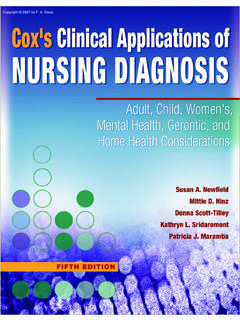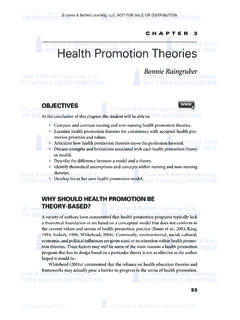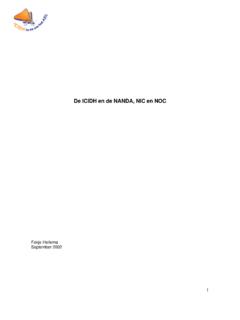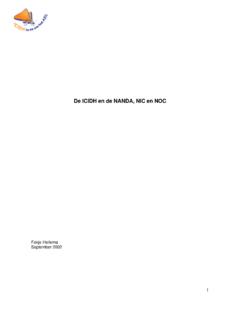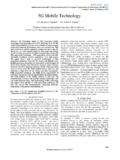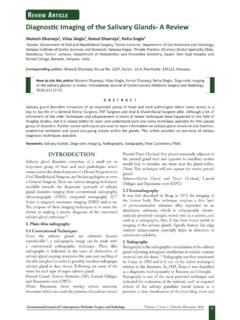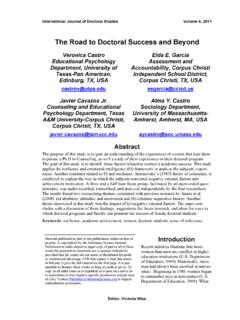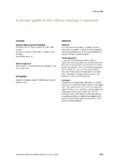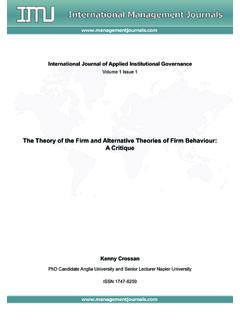Transcription of JAN JOURNAL OF ADVANCED NURSING - Verpleegkunde.net
1 DISCUSSION PAPERW hither NURSING Models? The value of NURSING theory in the contextof evidence-based practice and multidisciplinary health careNiall McCraeAccepted for publication 23 July 2011 Correspondence to N. McCrae:e-mail: McCrae PhD RMNL ecturerMental Health NursingFlorence Nightingale School of NURSING &Midwifery, King s College London, UKMCCRAE N. (2012)MCCRAE N. (2012)Whither NURSING Models? The value of NURSING theory in thecontext of evidence-based practice and multidisciplinary health ofAdvanced Nursing68(1), 222 : paper presents a discussion of the role of NURSING models and theory inthe modern clinical of NURSING have had limited success in bridging the gapbetween theory and on NURSING models and theory since the 1950s, from healthand social care against NURSING theory are challenged. In the current contextof multidisciplinary services and the doctrine of evidence-based practice, a uniquetheoretical standpoint comprising the art and science of NURSING is more relevantthan for theoretical framework should reflect the eclectic,pragmatic practice of educators and practitioners should embrace theory-basedpractice as well as evidence-based :evidence-based practice, NURSING models, NURSING theory, philosophyIntroductionThe legitimacy of any profession is built on its ability togenerate and apply theory.
2 While enjoying a cherished statusin society, NURSING has struggled to assert itself as aprofession. Despite efforts to improve its academiccredentials, the discipline lacks esoteric expertise, and whilean eclectic pragmatism may serve patients well, failure toarticulate a distinct theoretical framework exposes NURSING toexternal control (Macdonald 1995). Aggleton and Chalmers(2000, p. 9) assert: Until nurses themselves value the uniquecontribution that they make to health care and the specialbody of knowledge that informs their practice, the subordi-nate role to that undertaken by doctors will continue . Overseveral decades, scholars have attempted to encompass thetrinity of physical, psychological and social aspects of care intheories and models of NURSING , which were intended to guidepractice and provide a platform for training curricula andresearch, thus supporting the development of and misused, the models of NURSING thatpervaded preregistration training in the 1970s and 1980sfailed to bridge the gap between theory and practice.
3 Whileevidence of successful application has continued to flow inthe United States of America (Meleis 2007), where nursingscience is supported by substantial funding by federalgovernment and private foundations, NURSING models fadedfrom professional discourse in the United Kingdom. 2011 The Author222 JOURNAL of ADVANCED NURSING 2011 Blackwell Publishing LtdJANJOURNAL OF ADVANCED NURSINGH owever, it could be argued that the baby was thrown outwith the bathwater, and there is now a growing movement torejuvenate NURSING theory (Pridmoreet ). The Mag-net Recognition Program (American Nurses CredentialingCenter 2008) is an international accreditation of excellence innursing, and a key requirement for organizations is todescribe and implement a professional practice model. Theauthor, who is involved in introducing such a model in a largemental health service provider, argues that theoretical devel-opment is crucial to the progress of NURSING as a models were identified in the 1950s, as a thinkingprofession began to emerge from its traditional handmaidenstatus, with a primary objective to advance from a narrowfocus on illness to a broader concern with human needs.
4 Thefirst recognized theory of NURSING was by Hildegard Peplau,who was highly influential in reconceptualizing the role from doing things to people to a therapeutic the barriers faced by nurses at the time, Peplau sInterpersonal Relations in Nursingwas completed in 1948but not published until 1952 due to lack of medicalco-authorship or endorsement (Johnson & Webber 2005).Influenced by the psychodynamic psychiatrist Harry StackSullivan and the human motivation theory of AbrahamMaslow, Peplau emphasized the nurse (rather than physicaltreatments and service organization) as the agent of her expertise was in psychiatric NURSING , Peplaudescribed an interactional process relevant to all nurses: Orientation person feels a need and seeks professionalhelp; nurse helps patient understand problem.
5 Identification patient relates to someone who they believecan help. Exploitation patient attempts to make most of helpingsituation; nurse formulates goals for patient. Resolution patient discards previous goals and acceptsnew goals, while relinquishing dependence on important step for theorists was to provide a definitionof NURSING . In the textbookThe Principles and Practice ofNursing(Harmer & Henderson 1955), Virginia Hendersonpresented NURSING as a response to human functional health with independence, she described 14 funda-mental needs: breathing, eating and drinking, eliminating,mobilizing, sleeping and resting, dressing, maintaining bodytemperature, cleaning and grooming, avoiding injury, com-municating and expressing emotions, worshipping, working,playing and learning. Although Henderson and Peplauintended their theories to apply across the spectrum of caresettings, the contrast between the mindsets of general andmental NURSING are evident the theoretical enterprise gained momentum, modelsdiversified, each based on assumptions about human natureand nurture, and extending to the wider socio-environmentalcontext.
6 Systems thinking was prominent in the AdaptationModel of Sister Callista Roy (1980), who described a naturalhuman tendency towards biological, psychological and socialequilibrium, with maladaptive responses the target of nursingintervention. Drawing on her scientific education, polymathRogers (1970) devised a novel theory of the human being as aunitary energy field in dynamic interaction with the environ-ment. Rejecting a Cartesian division of somatic and mentalfunctioning, Rogers propounded holism in its true and illness were reinterpreted as manifestations of therhythmic fluctuations of life, and the role of the nurse was todecipher each patient s patterns, and to promote synergy withhis or her surroundings. Riehl s Interaction Model (1980),based on the symbolic interaction theory of Chicago sociol-ogists, emphasized unique meaning in each situation, with thenurse helping the patient to acquire or adapt roles in responseto health changes.
7 Citations in the NURSING literature(Alligood 2002) indicated that the most widely used modelis that of Orem (1991), which facilitates progress from self-care deficit to independent living authorship of NURSING theory has reflected the relativelyadvanced intellectual culture of NURSING in the USA. In the fifthedition ofNursing Theorists and Their Work, a compendiumof NURSING models (Marriner-Tomey & Alligood 2002), all butone model was from North America (later editions have widerinternational representation including the work of KatieErikkson; Alligood & Marriner-Tomey 2010). The exceptionwas by British nurses Nancy Roper, Winifred Logan and AlisonTierney (1980), who orientated NURSING to 12 activities ofliving: maintaining a safe environment, communicating,breathing, eating and drinking, eliminating, personal cleansingand dressing, controlling body temperature, mobilizing, work-ing and playing, expressing sexuality, sleeping and with Henderson are clear, but Roperet applied the NURSING process, with its logical sequence ofassessment, planning, implementation and this briefresume , theorists have attempted in variousways to present a comprehensive, rational and systematicapproach to NURSING .
8 With a plethora of models and theories,various classifications have been offered; Aggleton andChalmers (2000), for example, categorize models as devel-opmental, systemic or interactional. Unwittingly, such epis-temological discussion has muddied the waters, as illustratedby McKenna and Slevin (2008, p. 109): Callista Roy s workwas seen as a conceptual framework by Williams, a grandJAN: DISCUSSION PAPERThe value of NURSING theory 2011 The AuthorJournal of ADVANCED NURSING 2011 Blackwell Publishing Ltd223theory by Kim, an ideology by Beckstrand and as neither amodel nor a theory by Webb . Meleis (2007, p. 40) arguedthat differences are tentative at best, and hair-splitting,unclear and confusing at worst . Semantic resolution is notattempted here, but the definition of a NURSING model by Riehland Roy (1980, p. 6) may be helpful:A systematically constructed, scientifically based and log-ically related set of concepts, which identify the essentialcomponents of NURSING practice together with the theoreticalbasis of these concepts and values required for their use bythe hierarchical clarification is provided by Fawcett (2005),ranging from metaparadigms (the most abstract) to empiricalindicators (the most concrete).
9 Between these poles, nursingtheorists have provided plenty of conceptual models, but not somuch at the level of theory, which comprises testable propo-sition on which may be generated evidence of utility and anticipated that models of NURSING would enablepractitioners to become more autonomous and accountablein their clinical decisions and organization of care, whileboosting the development of NURSING as a discipline. So whathas gone wrong? Instead of elevating NURSING to the sunnyuplands of theoretically grounded practice, models have beenperceived as unrealistic dogma from the ivory towers, and asdiversions from intuitive care; consequently, manuals gatherdust on library shelves. Constructing, teaching and applying atheory of NURSING is undoubtedly a great challenge, but that isno justification for abandoning the endeavour. Practicalapplication has been hindered by a range of constraints, butall of these may be sourcesThis paper was informed by literature on NURSING models andtheories from the 1950s to date, with material gathered fromISI Web of Knowledge and other health and social caredatabases.
10 Use of literature was not driven by search strategybut as a qualitative selection of the major contributions totheory and relevant against NURSING modelsVarious arguments presented against NURSING models arescrutinized eludes definitionHesook Suzie Kim argues (2000, p. 2) that a rigorous andexact delineation of NURSING as a role and as a scientific dis-cipline is necessary specifically when it is used as the con-ceptual basis for the development of NURSING s theoreticalknowledge . Yet despite protracted debate, a consensualstatement on the meaning of NURSING remains elusive. With-out a satisfactory definition, how can a theory of NURSING beproduced? To accommodate the diversity of practice, theconcept of holistic care is often presented as a definingstatement. Models devised by writers of general hospitalbackground have been perceived as incompatible with spe-cialties such as mental health (Gournay 1995), and clearly forthe patient in acute nephritic pain immediate physical inter-vention is a priority over attending to existential needs, but tocompartmentalize bodily and psychological care would beregressive to a holistic ethos.
